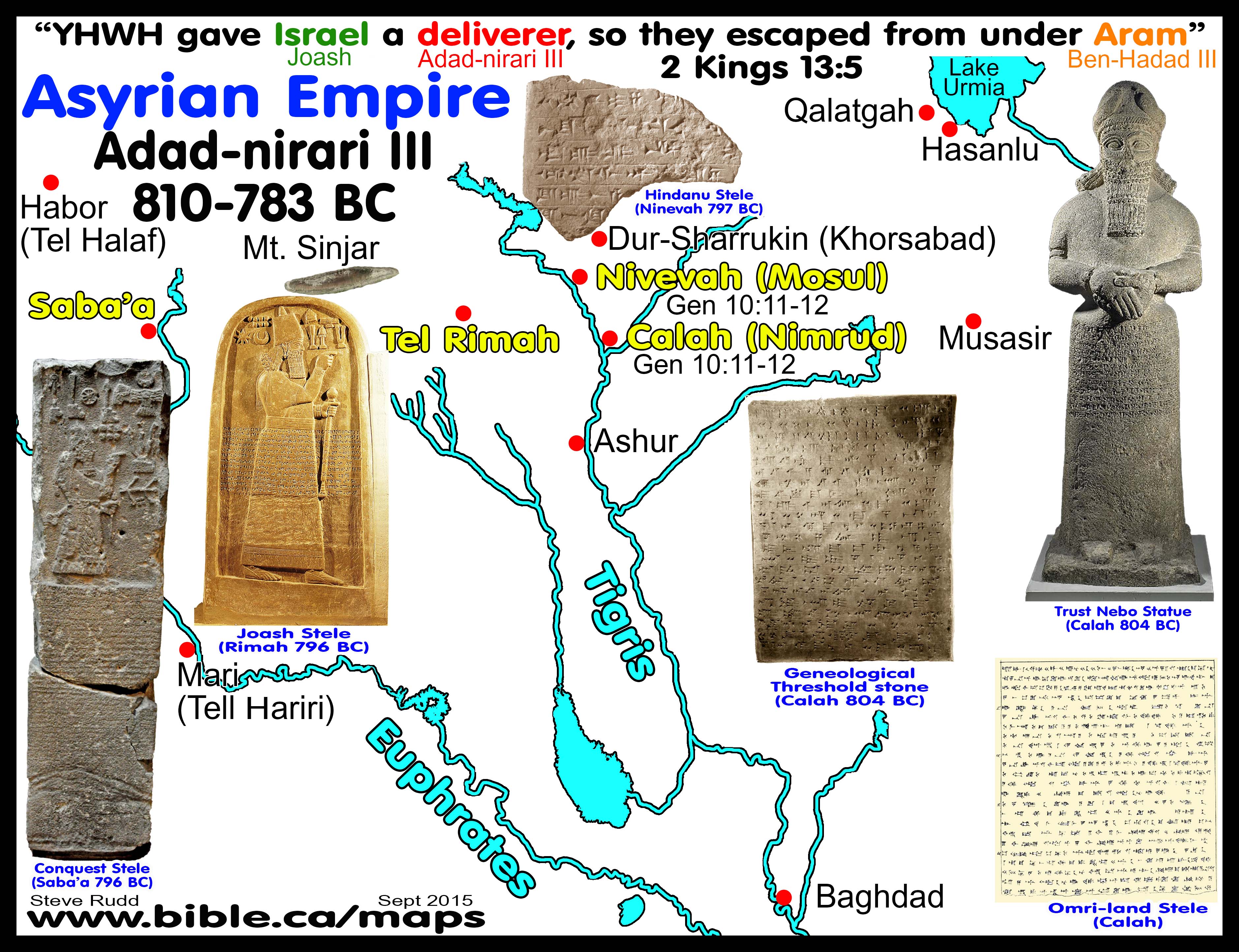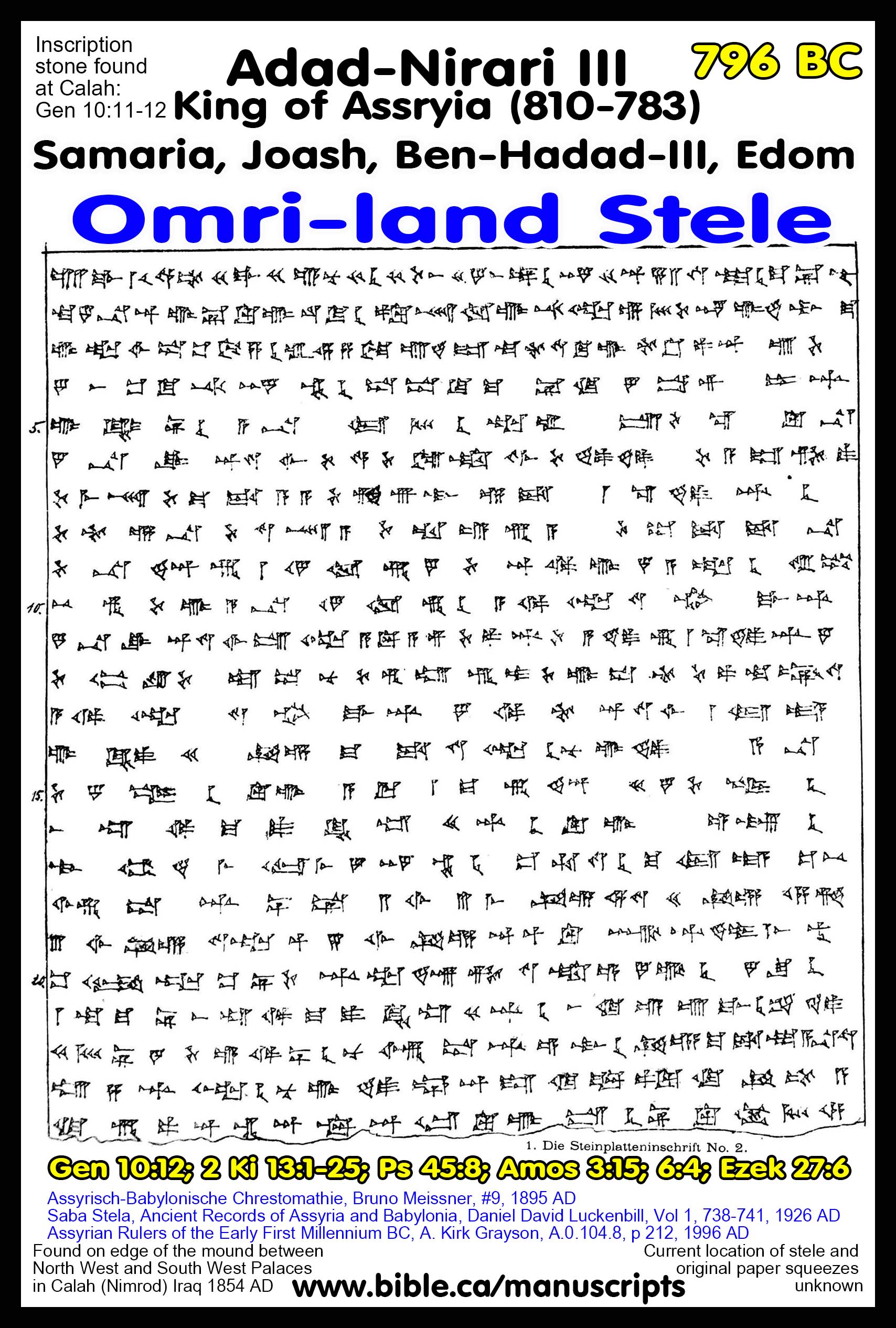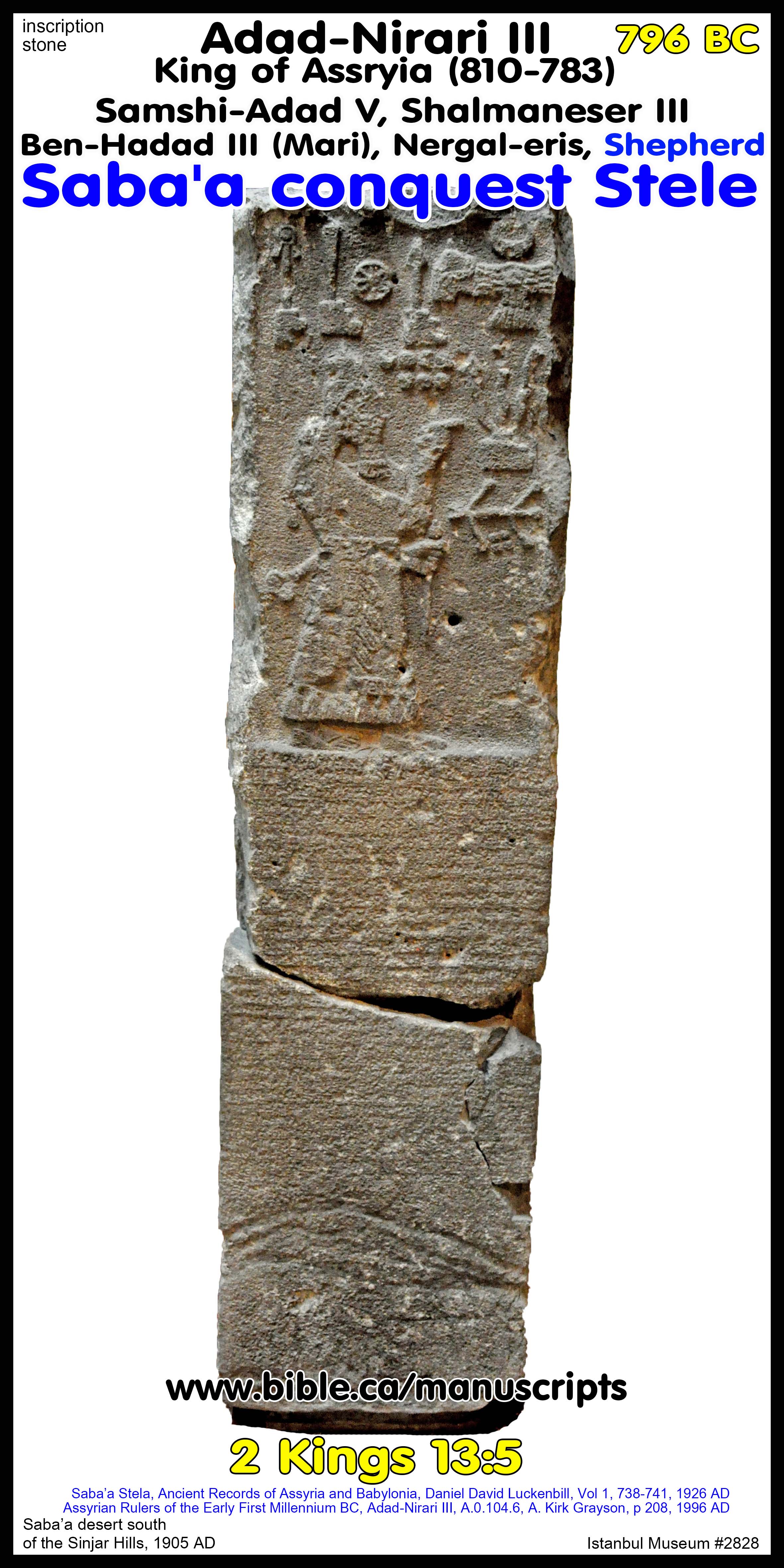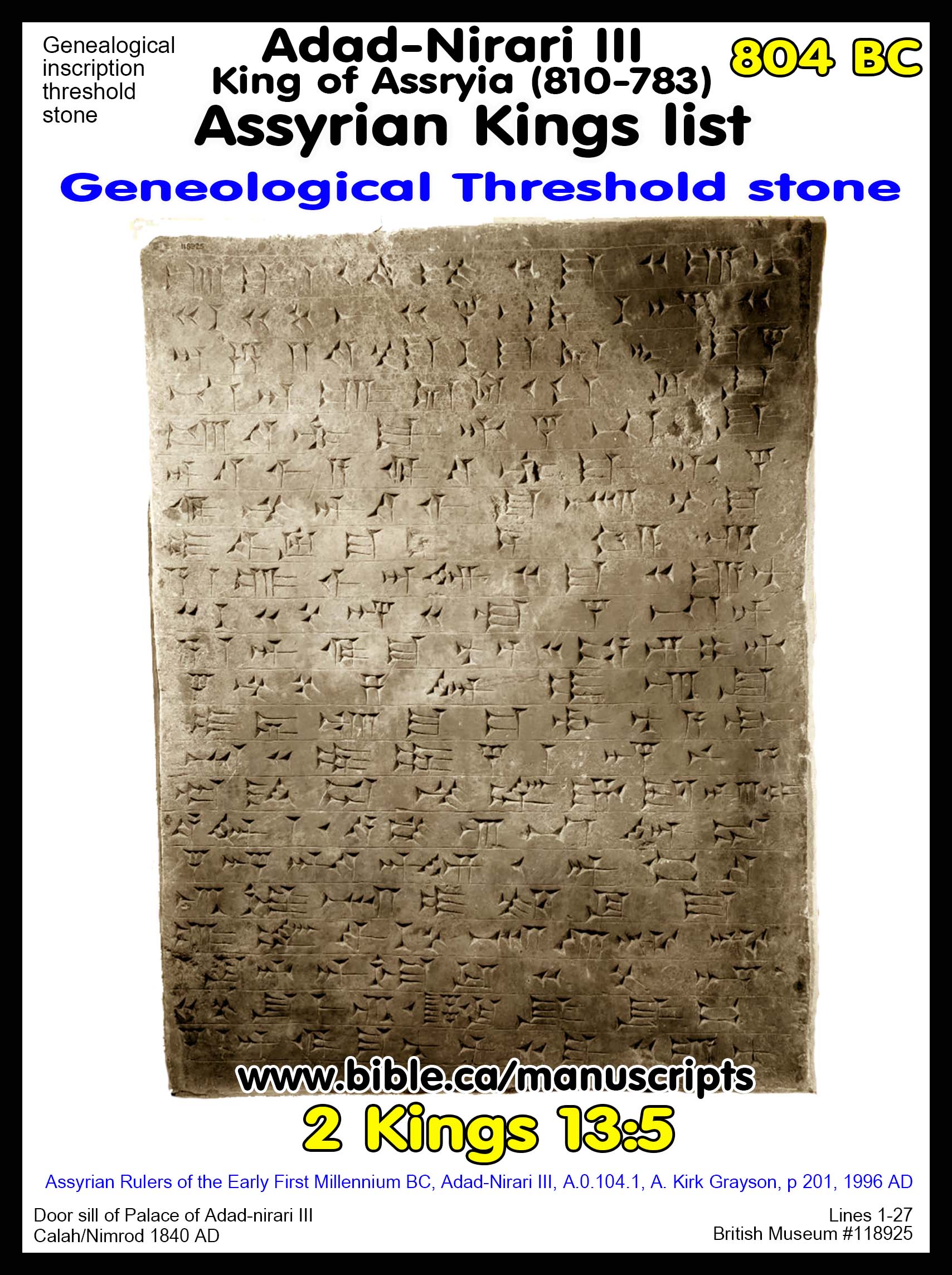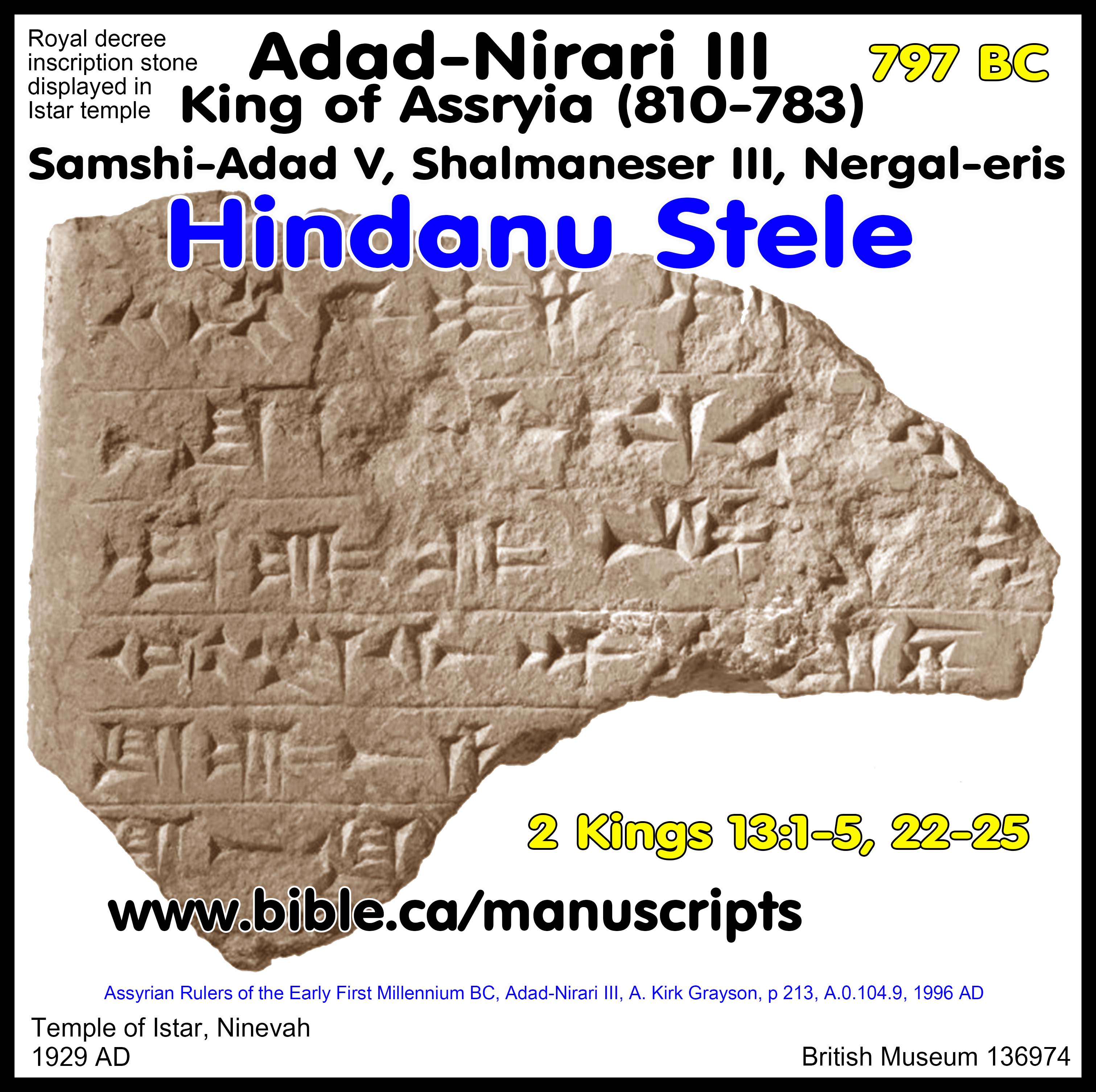Adad-Nirari III, King of Assyria (810-783) "The Unknown Deliverer of Israel of 2 Kings 13:5
"YHWH gave Israel a deliverer, so they escaped from under Aram"
|
Adad-Nirari III (810 - 783 BC) "The unknown deliverer" |
||
|
2 Kings 13:5 |
||
|
"YHWH gave Israel King Jehoahaz & Joash (Israel) |
a deliverer King Adad-nirari III (Assyria) |
they escaped Aram" King Ben Hadad III (Aram) |
Archeological Stele, Inscriptions, Tablets and Statues that confirm the Bible.
Paul preached about the unknown God and this outline is about the UNKNOWN DELIVERER of 2 Kings 13:5
"For while I was passing through and examining
the objects of your worship,
I also found an altar with this inscription, ‘TO AN
UNKNOWN GOD.’
Therefore what you worship in ignorance, this I
proclaim to you."
(Acts 17:23)
|
Digging up Bible stories!
"What we read in the book, we find in the ground"
God sent Israel (Jehoahaz and Joash, Samaria) a deliverer (Adad-nirari III, Assyria) they escaped Aram (Ben Hadad III, Aram) 2 Kings 13:5
|
|
2 Kings 13:5 |
||
|
"YHWH gave Israel King Jehoahaz & Joash (Israel) |
a deliverer King Adad-nirari III (Assyria) |
they escaped Aram" King Ben Hadad III (Aram) |
|
Conquest Stela of Adad-Nirari III (810 - 783 BC) Detailed outline on Adad-Nirari III . |
||
|
Religious and dynastic Stela of Adad-Nirari III (810 - 783 BC) |
||
Introduction:
- Like Joash king of Judah, Adad-Nirari III was coregent with his mother Semiramis for 6 years from 810-804 BC:
- Like Joash king of Judah who inherited the throne at age 1 and his queen mother Athaliah ruled for 6 years, Adad-Nirari III’s mother Semiramis was queen for 6 years.
- We don’t have any solid information that Semiramis was coregent, but she did play a unique central role since she is named on several inscriptions.
- "Our primary source for the history of the reign of Adad-nirari III (805-782 B.C.) is the inscription on a stele erected by one of his officers, Nergalerish, and discovered, 1905, in the desert south of the Sinjar Hills. The stele is now in the Constantinople Museum. … Of particular interest to the historian was the reference to the king's accession to the throne in his fifth year. This means, of course, that his mother, the famous Semiramis, was actually ruler of Assyria for five years." (Saba'a Stela, Ancient Records of Assyria and Babylonia, Daniel David Luckenbill, Vol 1, section 732, p 260. 1926 AD)
- A most unusual aspect of the reign is the high profile of the queen mother, Semiramis, whose name appears in royal inscriptions (A.0.104.3 and cf. A.0.104.2002) and who even had her own inscribed stele (A.0.104.2001). The atypical nature of the reign is apparent when one turns to the royal inscriptions.” (Assyrian Rulers of the Early First Millennium BC, Adad-Nirari III, A. Kirk Grayson, p 200, 1996 AD)
- The key reason why there was likely a coregency is because two inscriptions describe Adad-nirari III beginning his military action in the 5th year of his reign, which would correspond to 799 BC which is a perfect fit with 2 Ki 13:5.
- If we take the 5th year from 810 it gives us a date of 805 BC, but Ben-Hadad III wasn’t ruling yet until 800 BC and this conflicts with 2 Ki 13:5 that says Jehoahaz king of Israel was liberated from under Ben-Hadad III.
- “Only the beginning of one real annals text is preserved (A.0.104.1).” (Assyrian Rulers of the Early First Millennium BC, Adad-Nirari III, A. Kirk Grayson, p 200, 1996 AD)
- We know that queen mother Athaliah was counted as a real monarch because her six years ruling Judah were not included in Josiah’s total years. This in spite of the fact that the standard dating formula used for all other kings was never applied to Athaliah or her reign. (ie. In the 5th year of xx king of Judah, xx became king of Israel and he reigned 10 years)
- The 5th year military actions on the Rimah Joash Stele and the Saba’a Conquest Stele of Adad-nirari III:
- This notation has caused a lot of problem for chronologies.
- Recognizing the coregency with his mother “Semiramis” for 6 years is part of the solution.
- The second problem with the 5th year notation on these two stele is the mention of Joash king of Israel.
i. We are certain that that Adad-nirari III ascended the throne in 810 BC and Joash king of Israel ascended the throne in 798 BC, so even with the 6 year coregency and adding the 5th year we still only come down to 799 BC which is one year before Joash became king. To make matters worse, scripture indicates the events named on the two stele that involved of Joash occurred around 797 BC.
- The solution to the second problem is to view the conquests of Aram beginning in the 5th year and continuing for a period of time until completion in 797 BC. This appears to be correct because “we know from the eponym chronicle, there were several campaigns to the west, between 805 and 796 BC, and the description on this stele is just a brief summary of these events.” (Assyrian Rulers of the Early First Millennium BC, Adad-Nirari III, A. Kirk Grayson, p 208, A.0.104.6, 1996 AD)
- "Then the author [Saba’s Conquest Stele] introduces the military narrative with a date, "In the fifth year," and describes a campaign against Hatti and the submission of Damascus. As we know from the eponym chronicle, there were several campaigns to the west, between 805 and 796 BC, and the description on this stele is just a brief summary of these events. Perhaps the scribe chose to introduce the chronological note to indicate that these conquests began after "the fifth year." It is curious, however, that he did so, but then the text as a whole is strange: note the prominent role given to a governor, the unskilled manner in which the stone was carved, and the occasional faults in syntax. A date for the text can confidently be given as 797 BC, or later, since it was in that year that Hindanu was added to Nergal-eris's domain by royal decree (see A.0.104.9)." (Assyrian Rulers of the Early First Millennium BC, Adad-Nirari III, A. Kirk Grayson, p 208, A.0.104.6, 1996 AD)
- God’s two stage fulfillment of 2 Kings 13:5 over three years (799-796 BC): "The Lord gave Israel a deliverer, so that they escaped from under the hand of the Arameans; and the sons of Israel lived in their tents as formerly."
a. "Several events converged at the beginning of the eighth century to catapult Israel and Judah into prominence. The defeat of Aram-Damascus by Adad-nirari III about 796 bce liberated Israel from Aramean oppression." (The Eighth, the Greatest of Centuries? P. J. King, Journal of Biblical Literature, 108, p3, 1989 AD)
b. First stage: the prayer and humbling of Jehoahaz king of Israel (814-798 BC) was after Hazael died in 800 BC, so the prayer occurred in 799 and the deliverance in the last year of his life in 798 BC.
c. Second stage: happened in 796 BC and is witnessed in the stele of Adad-nirairi III and the Bible: "Then Jehoash (798-782 BC) the son of Jehoahaz took again from the hand of Ben-hadad the son of Hazael the cities which he had taken in war from the hand of Jehoahaz his father. Three times Joash defeated him and recovered the cities of Israel." (2 Kings 13:25)
- About the two Israeli kings:
- Jehoahaz king of Israel 814-798 BC
- Joash (Jehoash) was king of Israel 798-782 BC who had continued back and forth warfare with Ben-hadad III, king of Aram (son of Hazael).
2. Paul preached about the unknown God and this outline is about the UNKNOWN DELIVERER of 2 Kings 13:5
a. "For while I was passing through and examining the objects of your worship, I also found an altar with this inscription, ‘TO AN UNKNOWN GOD.’ Therefore what you worship in ignorance, this I proclaim to you." (Acts 17:23)
b. "The Lord gave Israel a deliverer, so that they escaped from under the hand of the Arameans; and the sons of Israel lived in their tents as formerly." (2 Kings 13:5)
c. That unknown deliverer was none other than Adad-Nirari III, king of Assyria!
- Three times Joash defeated Ben-hadad III, each time recovering the cities and territories of Samaria
- First: 796 BC: Hazael, Ben-Hadad III's father, had taken the land of Samaria but when Hazael died, Joash took back the land from his son Ben-hadad III. This is in 796 BC when God sent a "deliverer" (Adad-nirari III, king of Assyria) "Then Jehoahaz entreated the favor of the Lord, and the Lord listened to him; for He saw the oppression of Israel, how the king of Aram oppressed them. The Lord gave Israel a deliverer, so that they escaped from under the hand of the Arameans; and the sons of Israel lived in their tents as formerly." (2 Kings 13:4–5)
- Second: Ben-hadad III attacks and recaptures Samaria for a time, but Joash goes to war and recaptures it a second time.
- Third: Ben-hadad III recaptures Samaria and Joash recovers it third time.
- It is the first deliverance of Samaria in 796 BC by Adad-nirari III, king of Assyria that is recorded on these archeological stela:
- The Bible story of God saving Israel from Syrian through Adad-Nirair in 797 BC: 2 Kings 13:4-5
- Adad-nirari III is specifically but indirectly referenced in 2 Kings 13:5 as the "deliverer" sent by God to save Israel from Damascus.
- The entire story is told here: 2 Kings 13:1-5; 24-25
i. "In the twenty-third year of Joash the son of Ahaziah, king of Judah, Jehoahaz the son of Jehu became king over Israel at Samaria, and he reigned seventeen years. He did evil in the sight of the Lord, and followed the sins of Jeroboam the son of Nebat, with which he made Israel sin; he did not turn from them. So the anger of the Lord was kindled against Israel, and He gave them continually into the hand of Hazael king of Aram, and into the hand of Ben-hadad the son of Hazael. Then Jehoahaz entreated the favor of the Lord, and the Lord listened to him; for He saw the oppression of Israel, how the king of Aram oppressed them. The Lord gave Israel a deliverer, so that they escaped from under the hand of the Arameans; and the sons of Israel lived in their tents as formerly." (2 Kings 13:1–5)
ii. "When Hazael king of Aram died, Ben-hadad his son became king in his place. Then Jehoash the son of Jehoahaz took again from the hand of Ben-hadad the son of Hazael the cities which he had taken in war from the hand of Jehoahaz his father. Three times Joash defeated him and recovered the cities of Israel." (2 Kings 13:24–25) - The Saba'a Stele (with the help of the Hindanu Stele) confirms the Bible as true history!
- "Thereafter, Hazael savagely attacked Israel under Jehu, seizing Transjordan (2 Ki. 10:32–33), and throughout the reign of Jehoahaz, c. 814/3–798 bc (2 Ki. 13:22). But temporary relief did occur; the ‘deliverer’ sent by God then (2 Ki. 13:5) may have been Adad-nirari III of Assyria who intervened against Hazael" (The New Bible Dictionary, p 67, 1996 AD)
- "The Bible speaks of Jehoash’s military successes against Syria (2 Kgs 13:24) and against Judah (2 Kgs 14:8–14), but nothing is said about a contact with Assyria. That there was such a contact is now known because of a stele found at Tell al-Rimah in Iraq in 1967. The Assyrian king Adad-Nirari III (ca 811–782 BC) led a number of campaigns to the west during the course of his reign. On one of those campaigns he defeated Damascus and then collected tribute from Israel, Tyre and Sidon. On the way home, he erected a monument at Tell al-Rimah commemorating the event. The section of the stele which refers to Jehoash reads: “I received the tribute of Jehoash the Samarian, of the Tyrian [ruler] and of the Sidonian [ruler].”" (Bible and Spade, Vol 24, No 2, p 41, 2011 AD)
- Hazael was the father of Ben Hadad III, kings of Aram.
- Ben-hadad III is named "Mari" in three stele of Adad-nirari III: 1. Rimah Joash conquest stele, 2. Saba'a conquest stele, 3. Omri-land conquest stele
- "Mari" is a title of the kings of Aram applied to both Ben Hadad III on the Omri-land stele and his father of Hazael in other inscriptions.
- Detailed outline on Hazael, king of Aram and the "House of David" Stele found at tel Dan.
- This archeological object directly confirms a specific bible story where God sent Assyrian king Adad-Nirari III to deliver Israel from Ben-Hadad III (king of Arad at Damascus, son of Hazael) in 2 Kings 13:5.
- "So the anger of the Lord was kindled against Israel, and He gave them continually into the hand of Hazael king of Aram, and into the hand of Ben-hadad the son of Hazael. Then Jehoahaz entreated the favor of the Lord, and the Lord listened to him; for He saw the oppression of Israel, how the king of Aram oppressed them. The Lord gave Israel a deliverer [Adad-Nirari III], so that they escaped from under the hand of the Arameans; and the sons of Israel lived in their tents as formerly." (2 Kings 13:3–5)
- Hazael is the king who wrote the Tel
Dan Stele that lists 8 Bible kings and names. Ben-Hadad III was
Hazael's son! (note: Ben-Hadad II was succeeded by Hazael, the usurper.
Ben-Hadad III is the son of Hazael and is not on the Victory
stele of Hazael dating to 841 BC.
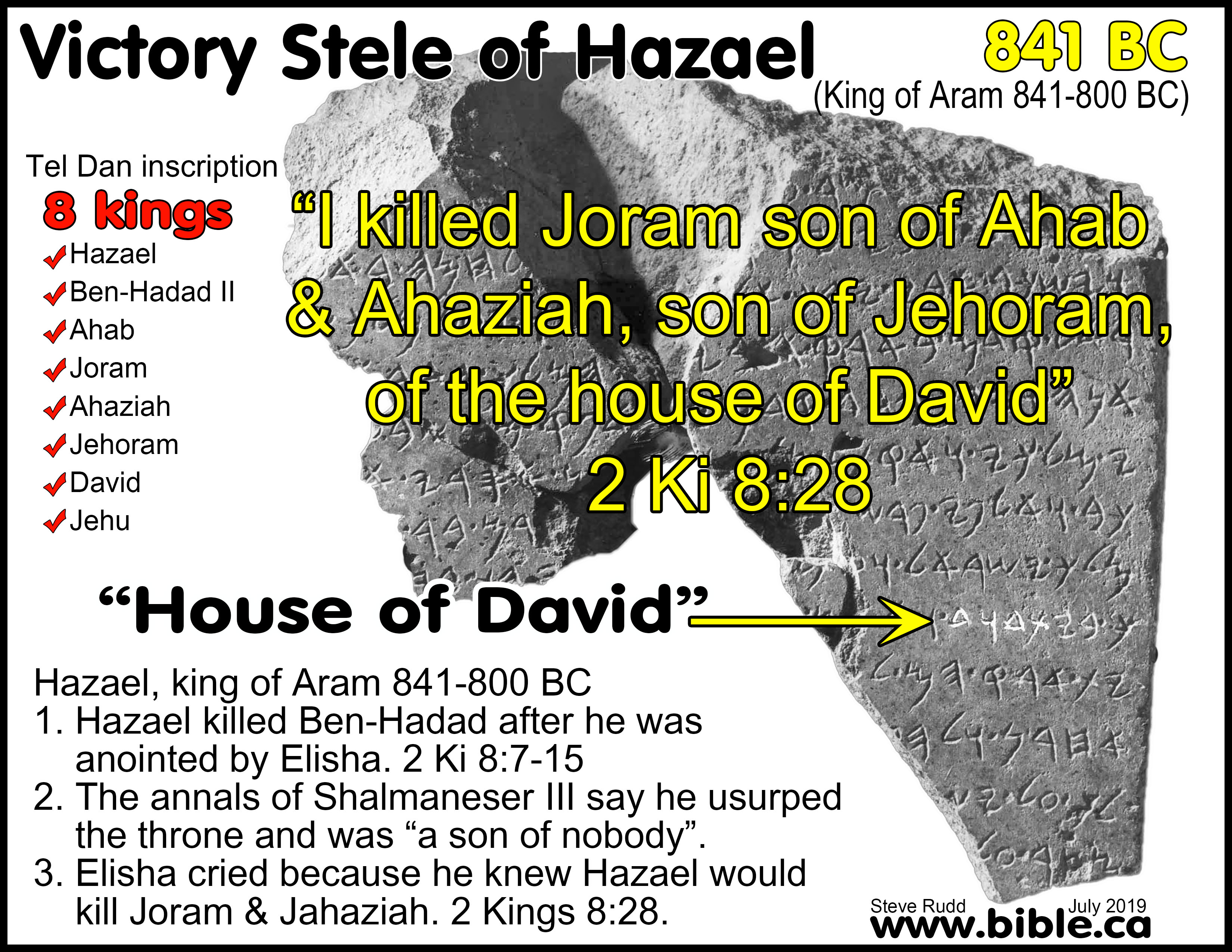
- Adad-nirari III describes himself in the Saba'a conquest stele as:
- A SHEPHERD: Adad-nirari III is called a "Shepherd" and describes his job as king as "shepherdship": "[Adad-nar]ari (III), king of the universe, king of Assyria, unrivalled king, marvelous shepherd, exalted vice-regent, whose prayers (and) sacrifices the great gods desired (and) thus made his shepherdship as pleasing as a healing drug to the people of Assyria and widened his land” (Saba'a Stele, Adad-nirari III, 796 BC)
- RIGHTEOUS: The gods eagerly desire the prayers and sacrifices Adad-nirari III makes to them: "[Adad-nar]ari (III) … whose prayers (and) sacrifices the great gods desired” (Saba'a Stele, Adad-nirari III, 796 BC)
- THE GREAT PHYSICIAN: "LIKE A HEALING DRUG": Adad-nirari III described himself as a cure for his nations problems. [Adad-nar]ari (III) … thus made his shepherdship as pleasing as a healing drug to the people of Assyria and widened his land” (Saba'a Stele, Adad-nirari III, 796 BC)
- What you read in the book you find in the ground!
I. About Adad-nirari, King of Assyria (810-783 BC):
- "Instability in domestic affairs was likely one reason for Adad-Nirari III’s military restraint. When Adad-Nirari ascended to the throne in 810 bc, the Assyrian empire had undergone a period of internal unrest. From the inscription record, it is evident that the final years of his grandfather, Shalmaneser III (r. 858–824 bc), and the reign of his father, Shamshi-Adad V (r. 823–811 bc), had been troubled by what might have been a sibling rivalry for the throne (Rainey and Notley, Sacred Bridge, 208; Hallo, “Qarqar,” 41–42). From the onset of his reign, Adad-Nirari III was thus forced to focus his attention on the inner stability of the empire." (Lexham Bible Dictionary, Adad-nirari III, 2015 AD)
- "Adad-nirari (810-783 BC) inherited an empire that was already suffering serious problems and by the end of his reign the Assyrian state was on the decline. A number of military endeavours took place during his rule, notably the capture of Damascus, and several building projects were carried out (see Grayson, CAH 3/1 pp. 271-76). A salient feature of the reign is the prominence of some Assyrian officials whose influence was so great that their names and deeds were recorded in royal inscriptions (see A.0.104.2, 67, and 9). A special discussion of these officials follows this introduction. A most unusual aspect of the reign is the high profile of the queen mother, Semiramis, whose name appears in royal inscriptions (A.0.104.3 and cf. A.0.104.2002) and who even had her own inscribed stele (A.0.104.2001). The atypical nature of the reign is apparent when one turns to the royal inscriptions. Only the beginning of one real annals text is preserved (A.0.104.1). On the other hand, records of royal campaigns are inscribed on boundary stones in which are recorded the circumstances surrounding the decisions on the boundaries (A.0.104.2-3 and cf. 4-5). Adad-nirari's building enterprises were spread over the main Assyrian cities. He worked at Calah (A.0.104.1, 8, and 19) and carried out extensive repairs to Fort Shalmaneser (A.0.104.17-18). At Nineveh he completed the palace begun by Samgi-Adad V (A.0.104.13, 15-16) and worked on the temples of Igtar (A.0.104.1002) and Nabil (A.0.104.14). Inscribed bricks of his from the Aggur temple at Aggur attest to construction there (A.0.104.12 and cf. 21) and precious stones with dedications to the goddess Mat-parsi show his concern for her shrine (A.0.104.10-11)." (Assyrian Rulers of the Early First Millennium BC, Adad-Nirari III, A. Kirk Grayson, p 200, 1996 AD)
- "Officials with Extraordinary Powers: A feature of the eighth century BC in the Assyrian empire is the emergence of officials with extraordinary powers. Most acknowledge the Assyrian king as their overlord; nevertheless more than one of them operates in practice as the supreme authority in his own right, within and even beyond his official domain (Cf. Grayson, CAH 3/1 pp. 273-79). Such officials frequently held office under more than one king in this period, beginning with Adad-nardri III at the start of the century, and ending with Tiglath-pileser III in the second half of the eighth century. They had inscriptions written to commemorate their deeds, just like an Assyrian monarch, and it is these texts which are of concern here. Most of the texts have the form of royal inscriptions and therefore I have included them, whether or not the Assyrian king is actually mentioned. In some cases, however, the inscriptions are not royal in form at all and the king is not mentioned; these are not edited here." (Assyrian Rulers of the Early First Millennium BC, Adad-Nirari III, A. Kirk Grayson, p 201, 1996 AD)
II. Master list of Assyrian kings in the Bible:
- Here is an almost complete list of Assyrian kings
- After the time of David and Solomon we have a complete list.
- The first Assyrian king to interact directly with a Bible story is Adad-Nirari III (810-783 BC) in 2 Kings 13:5
|
Name of Assyrian King |
Bible text |
|
1. Enlil-kapkapi (1800 BC?) |
- |
|
2. Sulili (1800 BC?) |
- |
|
3. Assur-Dan II (934-912 BC) |
- |
|
4. Adad-nirari II (911-891 BC) |
- |
|
5. Tukulti-Ninurta II (890-884 BC) |
- |
|
6. Assurnasirpal II (883-859 BC) |
- |
|
7. Shalmaneser III (858-824 BC) |
- |
|
8. Samsi-Adad V (823-810 BC) |
- |
|
9. Adad-nirari III (810-783 BC) |
Delivers Israel: 2 Kings 13:5 |
|
10. Shalmaneser IV (782-773 BC) |
- |
|
11. Assur-dan III (772-755 BC) |
- |
|
12. Assur-narari V (754-745 BC) |
- |
|
13. Tilgath-pileser III/Pul (744-727 BC) |
Menahem, king of Israel, pays tribute to Pul of 1000 talents of silver for protection in 742 BC: 2 Kings 15:19 Ahaz king of Judah, pays tribute to Pul for protection against Aram in 742 BC:2 Kings 16:7 |
|
14. Shalmaneser V (726-722 BC) |
Hoshea paid tribute in 726 BC: 2 Kings 17:3 Captivity of Israel in 723 BC: 2 Kings 17:6; 18:9 |
|
15. Sargon II (721-705 BC) |
Capture of Ashdod in 713 BC: Isaiah 20:1 |
|
16. Sennacherib (704-681 BC) |
Attacks Jerusalem, Hezekiah builds famous water tunnel and city walls in 701 BC: 2 Kings 18:13 |
|
17. Esarhaddon (680-669 BC) |
2 Kgs 19:37, Isa 37:38; Ezra 4:2 |
|
18. Ashurbanipal (668-627 BC) |
Manasseh deported to Babylon after 648 BC, then returned to power: 2 Chron. 33:10-13 (see note #1 below) |
|
19. Ashuretililani (626-623 BC) |
- |
III. Important names and details found in the six stela of Adad-Nirari:
- These 6 archeological artifacts include the names of these kings, many of whom are named in the Bible directly
- This is a stunning confirmation from archeology shows that what you read in the book, you find in the ground!
|
|
||||||
|
NAME |
||||||
|
Joash (Israel) |
|
|
|
|
|
|
|
Omri (Samaria) |
|
|
|
|
|
|
|
Mari, Ben-Hadad III (Aram) |
|
|
|
|
|
|
|
Enlil-kapkapi (Assyria) |
|
|
|
|
|
|
|
Sulili (Assyria) |
|
|
|
|
|
|
|
Assur-Dan II (Assyria) |
|
|
|
|
|
|
|
Adad-nirari II (Assyria) |
|
|
|
|
|
|
|
Tukulti-Ninurta II (Assyria) |
|
|
|
|
|
|
|
Assurnasirpal II (Assyria) |
|
|
|
|
|
|
|
Adad-Nirari III (Assyria) |
|
|
|
|
|
|
|
Semiramis |
|
|
|
|
|
|
|
Shalmaneser III (Assyria) |
|
|
|
|
|
|
|
Samsi-Adad V (Assyria) |
|
|
|
|
|
|
|
Nergal-eris (governor) |
|
|
|
|
|
|
|
Hindanu land |
|
|
|
|
|
|
|
Tyre |
|
|
|
|
|
|
|
Sidon |
|
|
|
|
|
|
|
Edom |
|
|
|
|
|
|
|
Philistines |
|
|
|
|
|
|
|
NAME |
||||||
|
|
||||||
IV. "Mari" in Rimah Stele is Ben-hadad III, king of Aram at Damascus:
- There are several inscriptions that reference Mari that have been discovered in archeology.
- The many inscriptions of Mari show it to be a title like King, Pharaoh or President or Prime Minister and is not a personal name.
- Both Hazael and his son Ben-hadad III were called "mr'(n)": Mari.
- "Page identifies IMa-ri-’i mātImeri-šú as Ben-hadad [III], the son of Hazael (Iraq 30 (1968): 149–150). The inscribed ivory from Arslan Tash states: הזאל למדאן showing that Hazael, king of Damascus had the title mr’(n). Since Hazael had the title, it is likely that his son Ben-hadad also held it on becoming monarch. Hazael ruled ‘all the days of Jehoahaz’ (2 Kings 13:22), which implies that he died either in the same year as Jehoahaz or later. Since Ia’asu is probably Joash, Mari’ may be either Hazael, or more probably his son Ben-hadad (2 Kings 13:25). Page suggests that since no verse in the Old Testament records either Adad-nirari’s intervention in Damascus or tribute given to the Assyrian monarch by Joash (or Jehoahaz for that matter), the Israelite king (Joash) took his chance by siding with the Assyrians when the Assyrians appeared at the gate of Damascus. Joash’s gift was then recorded by the Assyrian scribes (p. 150). (Ancient Conquest Accounts: A Study in Ancient Near Eastern and Biblical History Writing, K. Lawson Younger Jr., Vol. 98, p 122, footnote 103, 1990 AD)
- "Hazael was the scourge of Israel in the reigns of Joram, Jehu and Jehoahaz, fighting against Shalmaneser again in 837; with Joram at Ramoth Gilead in 843/2 (2 Kgs 8:28) and Jehoahaz (13:22). In old age he was a vassal of Adad-nirari III (c. 805/798) who referred to him as mari’. This could be a title (‘my Lord’) or a personal name, abbreviation of Mari’-Hadad, for an inscribed ivory from Arslan Tash (Til Barsip) reads ‘lord Hazael’ (mr’n ḥz’l). His name is also found on an ivory from Nimrud and written on a bead captured by Shalmaneser. A possible representation of him appears on another ivory (IBD, p. 612). He was succeeded by his son Bir-Hadad (Ben-Hadad III) who ruled c. 796–770 bc (13:24). The Aramaic Zakir stela inscription reads ‘Bar-Hadad bar (son of) Hazael, king of Aram’." (1 and 2 Kings: an introduction and commentary TOTC, p 227, 1993 AD)
- "More difficult is Mari of Damascus. Mari can be simply the Aramaic title, ‘my lord’ rather than a personal name. It has been suggested that the Assyrians referred to the Aramaean leader by this term because they were uncertain as to who he was. The Arslan Tash ivory might suggest that this was Hazael: ‘[]xx ‘m’ to our lord (mr’n) Hazael in the year [of the tak]ing of Ḥ[].’ A similar message is found on the Hazael booty inscriptions which seems to read something along the lines of the following: ‘That which Hadad (?) gave to our lord (mr’n) Hazael from Umeq in the year that our lord crossed over the river’. Others, however, would identify Mari with Bar-Hadad son of Hazael." (Ahab Agonistes: The Rise and Fall of the Omri Dynasty, L. L. Grabbe, p76, 2007 AD)
- Hazael (father of Ben Hadad III) is the king who wrote the
Tel
Dan Stele that lists 8 Bible kings and names. Ben-Hadad III was
Hazael's son! (note: Ben-Hadad II was succeeded by Hazael, the usurper.
Ben-Hadad III is the son of Hazael and is not on the Victory
stele of Hazael dating to 841 BC.

V. Idol pagan gods named in the tablets: Bel (Marduk), Bel, Hadad (Adad):
- For details of the idol gods of Adad-nirari
III and Ben-Hadad III, see this link: Trust
Nebo Alone Statue
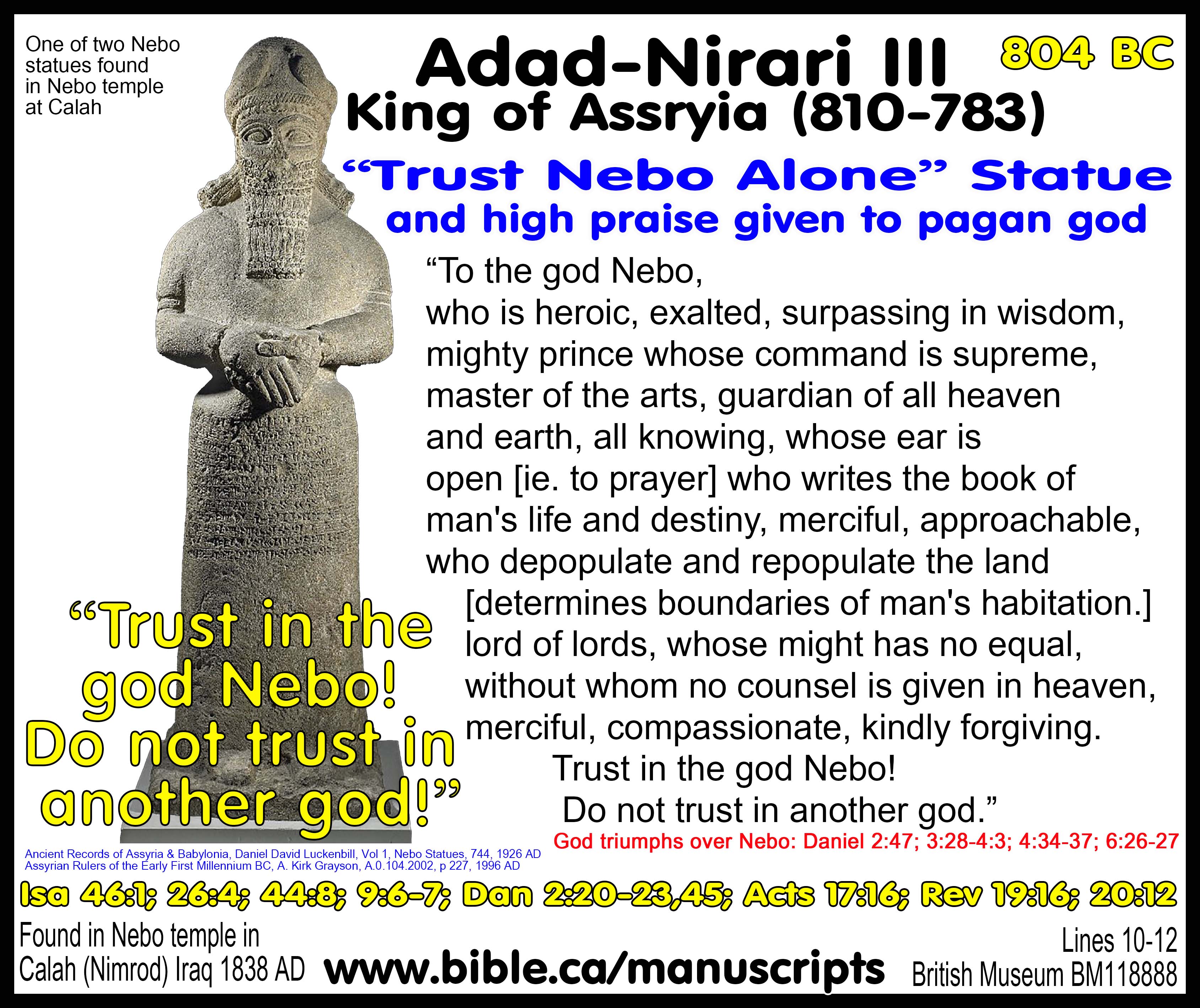
- It is amazing that both Adad-nirari III (king of Assyria) and Ben-Hadad III (king of Aram at Damascus) were named after the SAME PAGAN GOD: HADAD
- Adad and Hadad are two different spellings of the same "storm god"
- Adad-nirari III is literally “Adad is my helper"
- Ben-Hadad is literally "son of Hadad"
- We find the same thing true with all the Babylonian kings being named after idol gods Bel or Nebo. (Nebuchadnezzar)
- Notice Bel (Marduk) and Nebo in the names of Babylonian rulers and kings and the Meanings of names of Babylonian kings:
- Belteshazzar (Daniel): "Bel (Marduk) guard his life”
- Shadrach (Hananiah): "Marduk" (Bel) alternate corrupt spelling for Marduk
- Abednego (Mishael): "servant of Nebo" Nego is an alternate corrupt spelling of Nebo
- Belteshazzar (Daniel): "Bel (Marduk) guard his life”
- Nabopolassar: "May Nebo protect the son"
- Nebuchadnezzar: "O Nebo, defend the landmark"
- Evil-Merodach: "Man of Marduk (Bel)"
- Labashi-Marduk: "? Marduk (Bel)"
- Nabonidus: "Nebo is exalted"
- Belshazzar: "Bel (Marduk) protect the king"
- Nebuzaradan: "Nebo has given a seed"
- For details see this link: Trust Nebo Alone Statue
Conclusion:
- Twice Adad-nirari III is specifically but indirectly referenced in 2 Kings 13:5 as the "deliverer" sent by God to save Israel from Damascus.
- First, Jehoahaz king of Israel was delivered in 799 BC by the unknown deliverer (Adad-Nirari III) from under the bondage of Ben-Hadad III of Aram.
- Second, Joash king of Israel was delivered in 796 BC by this same unknown deliverer (Adad-Nirari III).
- The process took a few years but by 796 BC Ben-Hadad III was under the complete control of Assyria, who extracted tribute from Joash king of Israel in exchange for peace.
- In 797 BC, Assyrian king Adad-nirari III gives governor Nergal-eris the land of Hindanu as recorded in the Hindanu Stele. This allows us to accurately date three other important steles to 796 BC, the same year Adad-nirari III saved Israel (ten northern tribes) from Ben-Adad II, king of Aram at Damascus.
- Ben-hadad III king of Aram (son of Hazael) is named "Mari" in three stele of Adad-nirari III:
- Rimah Joash conquest stele
- Saba'a conquest stele
- Omri-land conquest stele
- See outline on Hazael, king of Aram, father of Ben Hadad III
- Infant Adad-nirari III coregent with his mother Semiramis:
- Young Adad-nirari III becomes king of Assyria but his mother “Semiramis” is coregent with him for 6 years.
- We do not know how old he was when he became king, but the dynastic father son transmission of kings was as strong in Assyria as it was in Judah.
- Here we have two kings (Joash of Judah and Adad-nirari III) who ascended the throne as infants while their mothers (Athaliah, Semiramis) ruled the kingdom for them for 6 years.
- What is even more amazing is that they were king at the same period of time with an overlapping governorship of 14 years.
- This may have created an affinity between the Hebrews and Assyria as the two child kings governed their parts of the world at the same time.
- Joash king of Judah and Adad-nirari III were:
a. Both Infants when their fathers died
b. Both had coregent mothers (Athaliah, Semiramis)
c. Both had coregencies of 6 years
6. Summary of Adad-Nirari III’s reign:
a. Six-year coregency with mother “Semiramis”: 810-806 BC
b. First functioning year as sole monarch: 806 BC
c. 5th year of reign as sole monarch on Stele: 799 BC
d. 4 year Fulfilment of 2 Ki 13:5: 799 BC (Jehoahaz/Israel) - 796 BC (Joash/Israel)
e. Dies and his son Shalmaneser IV becomes king of Assyria
- ADAD-NIRARI WAS A FAKE AND A COUNTERFEIT! In the Saba'a conquest stele, Adad-nirari III describes himself as: A SHEPHERD, THE RIGHTEOUS, THE GREAT PHYSICIAN.
- Jesus Christ is the true Shepherd: "“All who came before Me are thieves and robbers (Adad-nirari III), but the sheep did not hear them. “I am the door; if anyone enters through Me, he will be saved, and will go in and out and find pasture. “The thief comes only to steal and kill and destroy; I came that they may have life, and have it abundantly. “I am the good shepherd; the good shepherd lays down His life for the sheep." (John 10:8–11)
- Jesus Christ is the only righteous advocated between God and Man in whom God is pleased: "My little children, I am writing these things to you so that you may not sin. And if anyone sins, we have an Advocate with the Father, Jesus Christ the righteous;" (1 John 2:1)
- Jesus Christ if the great Physician: "But when Jesus heard this, He said, “It is not those who are healthy who need a physician, but those who are sick. “But go and learn what this means: ‘I desire compassion, and not sacrifice,’ for I did not come to call the righteous, but sinners.”" (Matthew 9:12–13)
- The Rimah Joash conquest stele and the Saba'a conquest stele and the Omri-land conquest stele tells the exact story found in the Bible: 2 Kings 13:1-5; 24-25
- What you read in the book, you find in the ground! Find me a church to attend in my home town this Sunday!
By Steve Rudd: Contact the author for comments, input or corrections.
